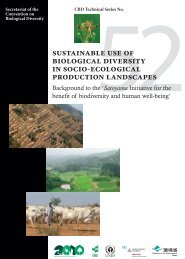INDIAN SCIENCE CONGRESS - India Environment Portal
INDIAN SCIENCE CONGRESS - India Environment Portal
INDIAN SCIENCE CONGRESS - India Environment Portal
Create successful ePaper yourself
Turn your PDF publications into a flip-book with our unique Google optimized e-Paper software.
14<br />
Proc. 98th <strong>India</strong>n Science Congress, Part II : Presidential Address<br />
higher. They contain low fat and carbohydrate and low energy, which can be<br />
beneficial in low caloric diets considerable amount of minerals, suggest their<br />
important role as mineral sources in human diet.<br />
The studies revealed that these mushrooms are similar to commercially<br />
cultivated mushrooms with regard to their cultural ability and chemical composition.<br />
There is need to develop and standardize the cultivation technology for these wild<br />
edible mushrooms. They are already accepted for consumption by local people.<br />
Nutraceutical potential :<br />
In past two decades mushrooms have assumed a greater role in maintenance<br />
of good human health because of their projected nutraceutical potential. This<br />
potential is enormous but untapped. The mushrooms possess antitumour,<br />
immunomodulating and hypocholesterolemic properties. Some well known medicinal<br />
mushrooms are : Ganoderma lucidum, Grifola frondosa, Trametes versicolor,<br />
Schizophyllum commune, Lentinula edodes, Agaricus blazeii and Cordyceps<br />
sinesis. The active constituents found in mushroom are : Polysacchanides, dietary<br />
fibers, Selenium oligosaccharides, triterpenoids, peptides, proteins, alcohol, Phenols,<br />
amino acids and mineral elements. They show anti-cancerous, anti-HIV, anti-viral<br />
activity and also ameliorate toxic effects of chemo and radiotherapy.<br />
Nutraceutical potential of morels has been investigated (Lakhanpal, et al.<br />
2010). Nutraceutical attributes of morels compare favourably with the mushroom<br />
species listed above. They are even a better source of Polysaccharides, crude fibre,<br />
nucleic acids,minerals especially Se, Zn, K, Cu, Na, and Ca, Vitamin (B 1 , B 2, C,A,<br />
D and K; proteins and all the essential amino acids. They are free from cholesterol.<br />
Hence they are good of nutraceutical use.<br />
Ethno mycological Studies :<br />
Ethno mycological studies were initially conducted on morels. These studies<br />
were conducted to gather information on methods of collection, myths associated,<br />
propagation in nature, local and vernacular names and recipes of morels in vogue<br />
with the local communities and to see the impact of morel collection on socioeconomic<br />
aspects of the inhabitants. It was revealed by survey that morels are<br />
collected by local inhabitants of all ages and creeds Shepherd, herdsmen, women<br />
and school going children are more active collectors. The nomenclature of morels<br />
and of other mushrooms varies in different valleys in the Himalayan region. They<br />
are commonly called “Guchhi” in the <strong>India</strong>n markets, but their vernacular names
















